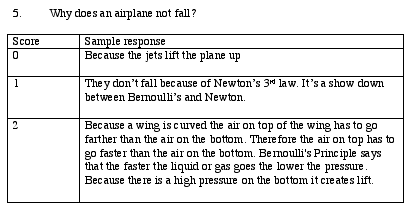Mapping Learning and the Growth of Knowledge in a Knowledge Building Community
Mary Lamon
Ontario Institute for Studies in Education of the University of Toronto
Richard Reeve
Institute of Child Study Laboratory School of the University of Toronto
Marlene Scardamalia
Ontario Institute for Studies in Education of the University of Toronto
American Educational Research Association Meeting 2001
Seattle, Washington
Session: 21.45
Abstract
Bereiter and Scardamalia (1996) argue that there is a difference between learning and knowledge building. Learning is activity directed towards improving personal knowledge. Knowledge building is trying to improve knowledge itself by considering ideas in regard to their strengths, weaknesses, applications, limitations, and potential for further development. Both learning and knowledge building are needed in schools. This paper traces the development of both in a Grade 5/6 classroom studying physical science.
Knowledge transforming discourse is central to knowledge building because
it is the means through which knowledge is formed, criticized, and amended
(Scardamalia, Bereiter & Lamon, 1994). In this knowledge building classroom,
the capacity for transformative discourse was afforded by Knowledge Forum®
and classroom processes. Our paper deals with how this class engaged in the
process of articulating and changing their learning goals as they reflected
on and evaluated their class' knowledge building progress. Our sources of
data come from discourse in the Knowledge Forum® database and videotapes
of classroom discussion. A second set of analyses designed to capture students’
activity in the database used data from the Analytic Toolkit, a suite of tools
designed to track each student’s use of Knowledge Forum. A third set
of measures came from a pretest and post-test of students’ knowledge
of physical science. Our results showed that students who engaged in knowledge
building discourse around central features of physical science also improved
their learning.
Knowledge Building
For the past two decades, Bereiter and Scardamalia and their colleagues have been researching and developing how to create knowledge-building classroom environments (Bereiter & Scardamalia, 1993; Scardamalia, Bereiter & Lamon, 1994; Bereiter & Scardamalia, 1996; Bereiter, Scardamalia, Cassells & Hewitt, 1997). In the best of these classrooms, we see students taking off with an idea that carries them into intellectual realms that adults find exciting. The students approach problems from multiple perspectives; engage in knowledge transforming discourse aimed at reconstructing their ideas both in Knowledge Forum and in face to face dialogue; and they work collaboratively to advance the knowledge of the class over a sustained period. Students learn to identify their own beliefs, bring those beliefs into contact with others’ beliefs and are proud of being in charge of their own learning.
As a class, students are trying to understand some aspect of how the world
works by producing conceptual artifacts – ideas that represent a continual
improvement in what the class knows. Students are not focused or distracted
by the need to produce a product or project to demonstrate their learning.
Instead their ongoing work in their Knowledge Forum database is both the product
and the impetus for further investigation.
Discourse is central in these classrooms. Although discourse is not the only
way to build knowledge we agree with Popper’s (1962) position that discourse
is the medium through which knowledge is formed, criticized, and amended.
Popper's distinction between Worlds 1, 2 and 3 may make this clearer. World
1 is the world of objects. Individual and even collective efforts to understand
objects are the work of World 2. "Karl Popper drew a sharp distinction
between knowledge as it exists in individual minds ("World 2") and
knowledge as an abstraction that (like the economy of a nation or the climate
of a classroom) exists above the individual level ("World 3"). He
saw the business of science as improving and advancing World 3" (Scardamalia
et al, 1994). Empirical research, although essential, does not directly yield
new knowledge; rather, it makes its contribution through being brought as
evidence into transformative discourse.
In support of discourse that transforms a community, Bereiter and Scardamalia
and their team created software, Knowledge Forum, a problem-centered collaborative
knowledge medium that operates over a computer network. In the database, students
and their teachers can create text and graphic notes, read and build onto
each others' notes, and create views to represent different aspects of their
collaborative work. The software provides the organization for any number
of small groups to carry on discussions and debates among themselves and with
each other; for students to join in the discussions of whatever group they’re
interested in, and to realign themselves with other groups. Knowledge Forum
allows the teacher as well as other students to monitor and contribute to
the developing lines of inquiry of each group. The computer system thus provides
the organization and support for the complex array of individual and group
discourse and development of ideas that constitutes a working knowledge-building
community (For more information please see http://www.KnowledgeForum.com).
In knowledge building classrooms, we see teachers who may not know all the answers in advance but because they are knowledge builders themselves they continuously research the domain looking for resources that will help the community advance. The teacher is not a guide or a coach but rather is someone whose understanding is regarded as an authoritative resource on the subject along with other sources. And so, the teacher’s own knowledge does not circumscribe what students will investigate.
Knowledge Building and Learning
As students develop their knowledge they need to learn facts and procedures to help them advance. For example, an understanding of why two objects with different mass fall at the same rate will require that students learn about Newton’s Laws. Students are not required to learn Newton’s Laws before understanding the rate of falling objects. Instead their study of falling objects leads them to try to understand Newton’s Laws. In the process of knowledge building they are mastering the key principles that underlie science and so are able to go well beyond learning the facts.
Knowledge building has an additional advantage: Students learn how to become
knowledge builders. They begin to identify their own ideas and to compare
and contrast their ideas with those of others; they need to look for inconsistencies,
strengths, weaknesses, applications, limitations, and potential for further
development between their ideas and those of others (Bereiter, in press).
This kind of discourse brings with it a metacognitive strength – knowing
one’s own mind, identifying skills and needs in how one approaches problems,
monitoring one’s own and others’ conceptual progress and taking
charge of one’s own growth in understanding.
In most cases, and especially in school, learning falls short of knowledge
building. One can learn the multiplication times tables without any understanding
of number sense. Or one can learn all of the important dates of events in
Canadian history without understanding why these events are important in understanding
how Canada has developed into what it currently is.
This is a case study of one knowledge building classroom. Given that this
is one classroom, we must be very cautious about over generalizing to other
classrooms. Nevertheless, the study may suggest what one might expect in other
classrooms implementing knowledge building.
Method
This study assessed student learning in the domain of physical science over the course of an academic year.
Participants
Participants were 22 students in one Grade 5/6 classroom at the Institute of Child Study Laboratory School of the University of Toronto. There were 11 girls and 11 boys in the classroom. All 11 Grade 6 students were in their third year in a Knowledge Forum classroom; 10 of the Grade 5 students were in their second year in a Knowledge Forum classroom and one student, a Grade 5 girl, was new to the school. Age-matched control groups for a pretest included 10 Grade 4 students and 11 Grade 6 students at the same school.
The Technology
In terms of the technology, this classroom had seven relatively old Macintosh computers networked to the Internet to the Ontario Institute for Studies in Education where their database was hosted. We suggest one computer for every five students and this classroom exceeded this bare minimum although several computers were usually not functioning.
The Domain
We conducted a brief literature review of young students’ understandings of selected aspects of gravity. In studies using a cross-sectional design methodology, students’ understanding was found to vary developmentally with more sophisticated explanations arising with age (Bar, Zinn, Goldmuntz, & Sneider, 1994; Von Pfuhl, 1980). Younger students explain that objects will fall if they are not supported (e.g., The sun, moon and clouds do not fall because they are held to the sky.); but older children bring in the concept of weight reasoning that only objects that are heavy will fall (Clouds are light and do not fall; boats float because they are light.). Most of this developmental research followed a Piagetian approach but results for any particular age varied with the particular study and Metz has argued that Piaget did not claim that development imposed curricular constraints on science education. The development research findings did influence the pretest that we devised for students.
Along with this developmental research, Chi (1993) has argued that concepts such as gravity require conceptual change because "gravity represents an acausal mutual attraction between two massive objects directed between their respective centers of mass. There is no direct causal agent of this force, at least within the formalism of classical mechanics".
We knew through discussions with physics experts about our previous classroom work (Lamon, Reeve & Scardamalia, 1997; Reeve & Lamon, 1998) that Newton’s Laws of Motion were essential to understanding physical science and that understanding these Laws was problematic. We planned to guide students’ into an exploration of Newton’s Laws.
The Intended Curriculum
Given our literature review and our past experience we then made use of the Ontario curriculum guidelines for elementary science and technology. We began by reading and highlighting the document and arrived at what we envisioned as the main learning goals. Newton’s Laws are not mentioned in the Ontario Guidelines but as already noted we intended to include them.
The Emerging Curriculum
In a knowledge building classroom, the teacher comes prepared with learning goals but because student inquiry is based on students’ own questions the curriculum becomes an emerging agenda between the teacher’s goals, the mandated goals and students’ interests. As the year progressed students’ questions led the class into other aspects of the Ontario guidelines ranging from Grade 2 to 8. Figure 1 shows the initial range of topics (in gray) and the emergent curriculum (in yellow) resulting from student inquiry.

Figure 1. Ontario curriculum guidelines for elementary science and technology. The boxes in gray represent our initial learning goals. Areas in yellow are areas that students brought to the classroom curriculum.
A "Curriculum Umbrella" was invented to help communicate to the students the scope of the curriculum that was being covered. The Curriculum Umbrella was a large poster on the wall and a View in the class Knowledge Forum database. The umbrella changed as students delved into areas not planned for.

Figure 2. The initial curriculum umbrella.
Classroom Processes
In most constructivist approaches there is an emphasis on deep disciplinary
principles which are decided in advance of classroom work (e.g., Brown &
Campione). While we had specified learning goals we also encouraged students’
self directed inquiry. To do so, the teacher began by asking students to bring
in questions and ideas from newspapers, television and other sources that
interested them. As so often happens, events in the world coincidentally met
with learning goals: At the beginning of this year the Swiss Air Flight 111
crashed off the coast of Nova Scotia and Ontario had an earthquake both of
which became objects for ongoing discourse.
All questions were written on index cards and posted to a bulletin board in
the classroom and each day several were discussed. As one example, there were
reports that American currency had been on the Swiss Air Flight 111. Students
wondered whether the money would disintegrate in salt water. One student’s
parent was in Scotland and was directed to bring back salt water from the
Atlantic Ocean. Students submerged an American dollar into the salt water,
put the container in the refrigerator and observed what happened to the money.
This was the beginning of inquiry time, a single period each day of the week,
with students’ questions leading the work and little teacher guidance
at this point. We have found that a slow period of getting started, where
the children feel ownership of the questions and the teacher keeps the ‘ends-in-view’,
is very productive as a way into sustained investigations by the children.
The emphasis on conducting experiments as the dollar example shows was also
important to students.
During this time students also began to create their Knowledge Forum database.
The teacher had intended to call the database "Wings, Weather and the
World" to follow the intended curriculum focus but students came up with
the name "Chance, Challenge and Change" which they believed mapped
onto their questions and concerns more closely so this was the name used.
The figure below shows the initial Views students constructed.
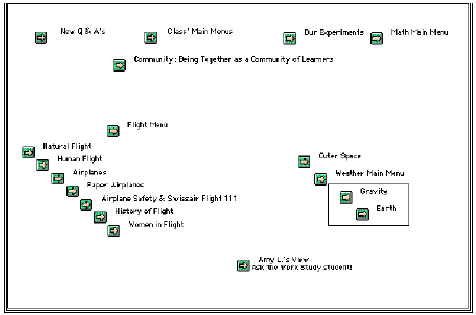
Figure 3a. Initial Views in Knowledge Forum constructed by students in November.
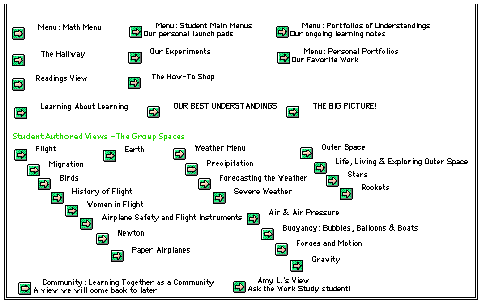
Figure 3b. The final set of Views in Knowledge Forum in May. Note that several Views, such as the Portfolio Views are also pointers to other Views.
One of their first inquiry topics was about the question of how planes fly. To begin, students made paper airplanes and most of their questions concerned variables that might affect whether and how their paper airplanes would fly.
Construction of scientific method through transformative discourse
In trying to understand why some planes flew and others didn’t and why different planes went at different speeds, students began to discuss keeping some variables constant and experimental replicability (not the word students used). We modified Brown and Campione’s crosstalk (1996) which is a whole class discussion aimed at understanding where students and groups of students have reached in their research. During a crosstalk, the teacher is an equal participant with students. In our modification of crosstalks, the students come to a crosstalk either with a knowledge advance or a problem of understanding; and notes and Views from the database are the focus of the discussion. The purpose of these modifications was to integrate transformative discourse in the database with transformative discourse in face to face interactions. As one student noted in his portfolio:
| Debates. This year debates are huge. Everyone's arguing if something is right or if something is wrong or just theories. If someone or a few people aren't sure if something is right or wrong they'd find some resources to suit their view of the subject and probably experiment so they could have full evidence of their idea, and the opposing group would do the same thing making the debate fuller. |
In this particular crosstalk, students came up with a set of scaffold supports to use in their Knowledge Forum notes on experiments. Scaffold supports are designed to support reflective processes during writing and problem solving. Scaffold supports originated in Bereiter and Scardamalia’s (1987) work on procedural facilitation to support knowledge transforming strategies in writing. Using cue cards to support reflection, students improved the quality of their writing, showed an increased ability to monitor and analyze thinking and a heightened awareness of the need for planning during writing. In Knowledge Forum a set of theory building scaffold supports (My Theory, I need to understand, New Information, A better theory, and Putting our knowledge together) come with the software. However, participants also customize scaffold supports for a particular domain or purpose. The reasoning is that the kinds of thinking in science differ from the kinds of thinking involved in historical reasoning, for example. The scaffold supports students invented for experiments were Question or Problem, Hypothesis, What Was Tried, Observations, and What was Learned. By generating hypotheses, recording observations, and so forth, the students realized that the amount of duct tape used on the paper plane made a difference, triangles made from plastic straws made the plane more durable and both wing and nose shape made a difference in whether the plane would get lift but they didn’t reach a conclusion on whether colouring the plane made a difference.
As Eleanor Duckworth commented, "The critical experiments themselves cannot impose their own meanings. One has to have done a major part of the work already, one has to have developed a network of ideas in which to imbed the experiments." Across the year, students also came to this realization. In final portfolio entries students reflected on knowledge building and several mentioned that experiments were one source of information but not the only source or the most important source. As one student commented
| The point is that This year in grade five, we learned by using both experiments and resources which we got from the Internet, books, magazines and other reading materials. The difference is that an experiment can sometimes turn out in different ways. But a resource is the result of many studies and experiments that professionals have proven. I have learned that both are important. I can't just depend on one experiment when the results may be different the next time I try it. Neither can I trust someone else without knowing if I can trust the person who wrote the resource. |
Along with experiments and a yearlong interest in understanding flight, students quickly began theorizing about the effects of gravity on flight. A new View on gravity was constructed. Initially, the questions revolved around trying to understand what gravity was. Many student notes showed that gravity was thought of as a thing that either did or did not exist in space. Through readings and especially the "gravity guys" (a group of three boys who took responsibility for understanding gravity) reading the history of astronomy and writing notes in the database most of the class came to understand that gravity is a force between masses.
Community Knowledge and Epistemic Agency through View Creation
A View in Knowledge Forum contains the notes in a graphical representation. Views allow users to see information from multiple perspectives, thus discovering new connections. Figure 4 shows a View about gravity.

Figure 4. A View showing students’ areas of exploration in gravity were astronomers, gravity on earth and in space. There main questions was "What is gravity?".
In most classrooms, the teacher creates Views and students write notes and sometimes create background graphics. In this class, the teacher gave groups of students the opportunity and responsibility for creating and maintaining Views. This gave each student a chance to add value to the community as a whole and each member shared responsibility for advancing the group's knowledge. Students were able to take charge of their own learning and showed a high level of responsibility for the creation of conceptual artifacts. As one student commented:
| Last year we had a few views that were cluttered with notes and a few views that barely had any notes or they were dead views (a dead view is a view that has absolutely no production/life). Our views were usually thought up by the teacher(s) and then we would use them and figure out they were ours. This year we were authors of practically all views and we made a good two thousand notes. We started with a few views (and I think we have at least one hundred-twenty views) but we had more new ideas so more views were made and some became cluttered so we had to make more views of the same subject in different sections for different aspects of the main subject. For example the Gravity view. Gravity started off as a view with a few notes here and there but it soon started to become a popular area in the database and also it became a popular debate area in the database. After that it started getting more attention and more notes, so naturally when that happened it became a heavily cluttered view so the Gravity view's authors asked The Gravity Guys had to do something about it. The result was making three different sections about the Gravity view's main aspects so it could be easier to locate specific questions and answers and facts, and for The Gravity Guys it was easier to organize their view. . . .Views are one of the main things that help keep our learning in one community. |
Symmetric Knowledge Advancement: Working Across Communities
In knowledge building environments, there is an interchange in knowledge work between all participants in a community and across communities, so that advances in one sector lead to advances elsewhere. At one point, we had students in our pre-service teacher education course visit this classroom’s database (Lamon et al, 1999). Adult students found lots of questions and lots of theories but couldn’t understand what students knew. At this point, we referred back to Brown and Campione's work on 'jigsawable' curricula (Brown, 1992). The strategies of having students create 'teaching notes' in their database, as a resource for their classmates was the result. This interaction seems to us to be one of symmetric knowledge advancement in that the adult students built upon what they had learned from the readings and in class discussions about knowledge building and used their knowledge in trying to understand the classroom’s database. Their interpretations of students' notes helped us recognize that although we wanted and had established conditions where children felt free to pose questions and articulate theories, the students needed to move towards explaining what they had learned. Figure 5 shows a teaching note.
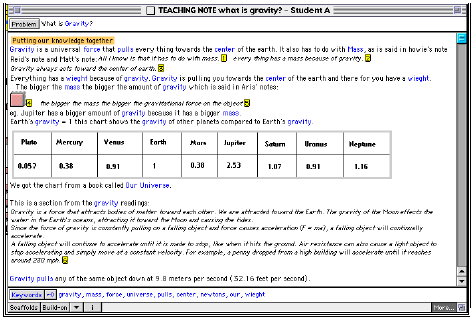
Figure 5: A teaching note explaining gravity.
In retrospect, we wonder if the teaching note was the ideal solution. In the teaching note, students tended to summarize their understanding but at times without explaining their reasoning and not pointing towards their ever-expanding fields of inquiry, problems, and discoveries. Even though students had difficulties with the rise above note feature in Knowledge Forum tending to use it to vacuum notes into one note some students did grasp the fuller meaning of a rise above note. A heated discussion arose within a small group of students with one group suggesting that a rise above note could be used to capture the many notes which all asked "What is gravity". Other students argued that this was a poor use of a rise above note because it was just using it as a vacuum. This interchange which was videotaped could have been used as a basis for a crosstalk on how to use rise above notes to explain intermediate solutions and conceptual products marking progress but still accepting diversity, complexity and messiness.
Assessment
In this classroom, several modes of assessment were used ranging from self-assessment to class assessment, quantitative assessment of students’ contributions to their database, and pretests and posttests of student understanding. Each is addressed.
A first and basic question concerns whether students did develop a deeper understanding of the physical world. Because this was knowledge building classroom where different students focused on a variety of issues we did not expect that all students would understand all issues equally. However, we did expect that through reading each others’ notes and through classroom discourse students’ understanding of some central issues would improve. Measuring improvements over time was one way to assess this.
Pretest and Post-Test
In the spring before the academic Grade 5/6 curriculum on physical science year, all students in Grades 4 and one Grade 5/6 class at the same school were given a pretest consisting of the following questions:
1. If your teacher lets go of an object it will fall. Why did the object fall?
2. Why do the sun and moon not fall?
3. Why do the clouds not fall?
4. Why do boats float on water?
5. Why does an airplane not fall?
For these five questions, we developed a holistic scoring scheme where non-normative
answers were given a score of 0 and answers approaching normative answers
were given a score of 2. Appendix 1 presents examples of answers that students
provided and the scoring rubric. Most non-normative answers relied on factors
concerning an object’s design -- boats are made of special materials
that make them float. As can be seen from the Table students’ understanding
did improve. We could not assess the Grade 4 students on the posttest because
they went into a Grade 5 class where the teacher was not involved in the research
and the Grade 6 pretest students had left the school.

One question, "why do boats float on water" is particularly interesting. This was not on the intended curriculum but arose because of one student’s question about gravity in water. Two girls decided to pursue this question which led to the concept of buoyancy. Initially, many students theorized that boats float because they have air in them. Several students offered counterexamples to this theory and one student went to a secondary school physics book where she read about Archimedes’ Principle. The concept was difficult for her and her classmates and she made several attempts to explain it to the class and revised her notes 34 times in the Buoyancy, Bubbles and Boats View about density and displacement of water. Twenty-one of the 22 students read these notes and on the posttest 14 students explained that boats float because the density of the boat is less than the density of the water displaced and four more used the concept of equal weights of the boat and water. One student across experimental and control groups who was also one of the investigators on the buoyancy of boats question answered this question correctly on the pretest. We found this to be a good example of knowledge building. Students’ questions drove the inquiry, students found authoritative resources on the concept, a student created a conceptual artifact (the notes) and other students read, discussed and understood the concept. It could be argued that this is an example of learning in that the posttest occurred about six weeks after the note was written but learning occurred through a knowledge building process.
Analytic Toolkit Results
Knowledge Forum has an analytic toolkit that tracks quantitative use of the database. Teachers use this data to track particular student’s use of the database. For example, if a student is writing many notes but is not reading other students’ notes the teacher would urge the student to read, reflect and then write. Most elementary school teachers do not use the analytic toolkit for assigning grades but more as a diagnostic tool. In this database, students created 1157 notes over the academic year. Each student had two to three hours per week to work in the database.
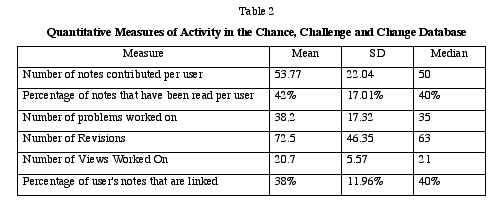
We are just beginning to collect enough data to compare quantitative measures across databases. As can be seen, student writing and student reading were quite balanced suggesting that students were as interested in others’ theories as they were in expressing their own theories. There was no significant correlation between the analytic toolkit measures and the post-test scores. To understand the relationship between post-test scores and the use of the database, we will need to identify the notes relevant to the questions more specifically as we did for the buoyancy question. Designing this measure is now being undertaken. Additionally, students studied many questions that the pretest did not ask about. The pretest/post test measure was useful in determining that student understanding was improving but did not help us understand how Knowledge Forum might, or might not, help to support the kinds of sustained and substantial inquiry and analysis that we all want students to achieve.
Portfolio Assessment
Knowledge building leads logically to the use of electronic portfolios. Both electronic and paper portfolios are used extensively for assessing student learning (Fogarty, 1996; Lankes, 1995; Wolf, Bixby, Glenn III, & Gardner, 1991) because they provide a change sensitive and comprehensive assessment for a wide range of learning outcomes, including problem-solving and critical thinking (Lamon, Abeyguarnadena, Cohen, Lee & Wasson, 1992). Portfolios both encourage and enhance the qualities of reflection and independent judgment necessary for students growing up in a complex technical culture. As well, the portfolio approach is a more authentic assessment tied more closely to classroom-based learning. Most electronic portfolios are static in nature and are used to document student development and not to engage and contribute to it (Fogarty, 1996; Lankes, 1995). In this classroom, portfolios were used dynamically so the students could use their portfolios to advance their knowledge as well as to record progress. We used three types of portfolio assessments: Two were individual student portfolios and one was a class portfolio. Students constructed all portfolios in their Knowledge Forum database.
Personal Portfolios
As illustrated in Figure 6, students designed their own background for their
personal portfolios Views and added notes that they felt represented their
best learning. Additionally, at the end of the year, each student wrote a
note about his or her own knowledge building and learning style. Two of these
notes were quoted above. The following is another.
|
I learned many interesting things this year, but most importantly, I learned that learning is not all about WHAT you learn, it's about HOW you learn. If you do not learn right, you may make mistakes. Some ways of learning are more salient than others. Some ways of learning are harder to understand. Most of the time, salient is B-E-T-T-E-R.
|
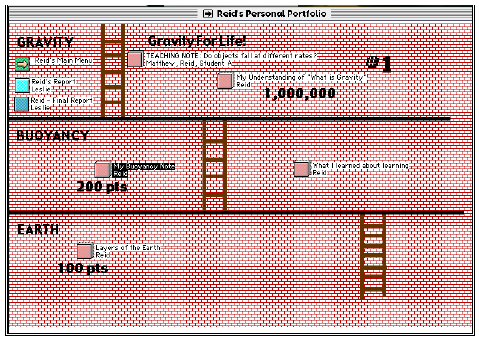
Figure 7. A personal portfolio View
In their final portfolio notes, the categories in Table 3 were identified. Most students mentioned that constructing your own theories and posing questions were central to knowledge building. Students found that both experiments and resources were useful. Their high evaluation of research and resources is interesting, as this knowledge building move has been observed in other knowledge building classrooms (Bereiter et al, 1997) and has been identified as a knowledge building principle: Constructive use of authority. The idea behind this principle is that people who are skillful in working with knowledge weigh information sources; they give credit to expert opinions and claims, but they also look for consistency, recognizing that no information source is 100% dependable (Scardamalia, 2000). Nine students explicitly mentioned collaboration and 12 others identified the use of Knowledge Forum for working together. Not one student mentioned a product or project or test as an outcome even though these students had constructed paper airplanes, Bernoulli rings, devices for measuring air pressure, and had built an operational wind tunnel among other things. Instead, students wrote about being able to explain, developing an improved understanding or deep learning or a thirst for knowledge.
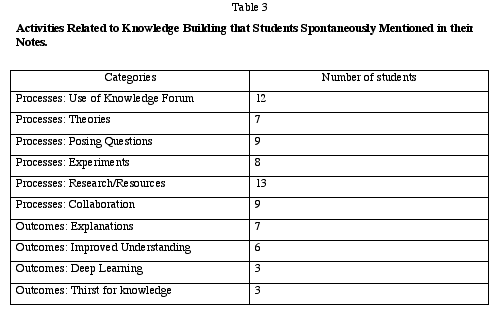
Students also constructed a portfolio of their understanding of central curricular concepts as is shown below.
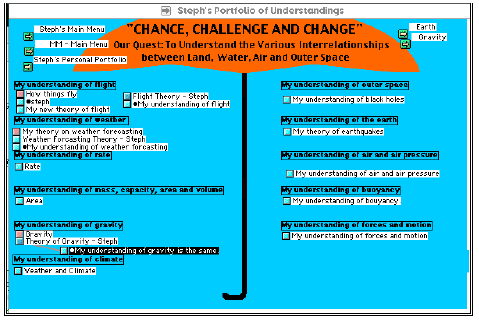
Figure 8. A portfolio of understanding note.
Many of these notes contained a sequence of growing understanding throughout the year. Archiving past theories was useful for students to advance their understanding. However, because the questions kept developing over the whole year it was difficult for students to keep up to date in this portfolio. In retrospect, we would recommend that teachers have students construct only one portfolio which would represent both notes that were meaningful to them as well as archived notes of understanding. Figure 9 shows archived notes on one student’s progress.
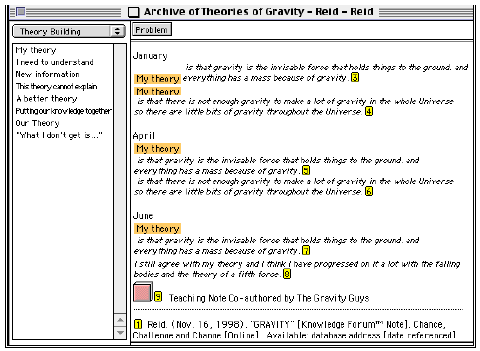
Figure 9. This shows archived notes of one student’s progress on the concept of gravity.
Class Portfolio
Finally, the class constructed a View called "Our Best Understandings". A student or a group of students was responsible for contributing to one or more sections of the View. The "teaching note" on gravity is one example as is the note on buoyancy.
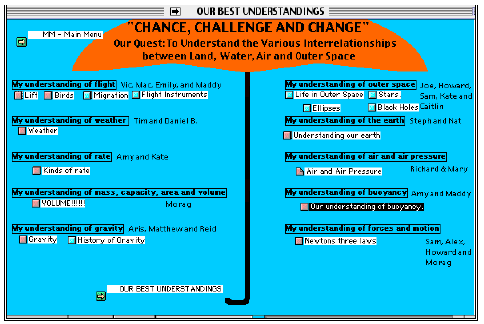
Figure 10. The class portfolio of understanding
The analytic toolkit provides an account of revisions by note authors (in red) and how many times students had read each note in this View. The results here are conservative because each of these notes contained references to other relevant notes that students had constructed. The number of readings for the boats’ notes, for example, shows that four students did not read the note. However in tracking the reference notes only one student had not read any notes referred to in the buoyancy note. Nonetheless, all students read some of the notes in this View. We suggest that, at a minimum, that a class Portfolio of understanding that students can learn from each others’ notes in the database.
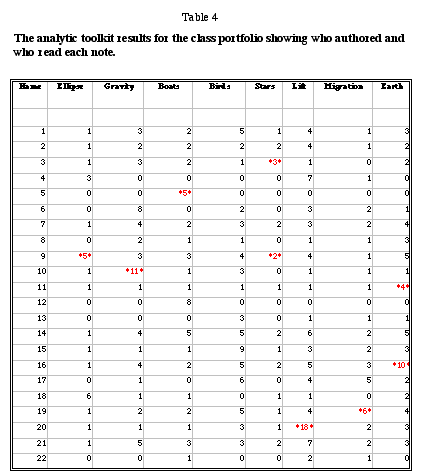
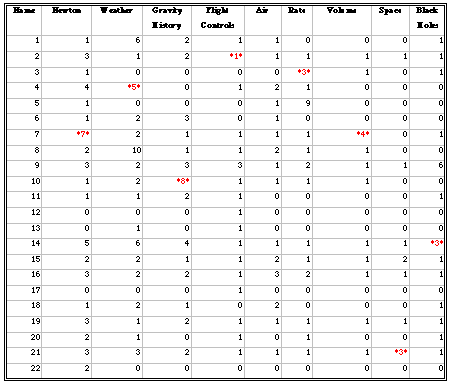
Conclusions and Lessons Learned
This report is meant to convey some elements of a knowledge building classroom using Knowledge Forum. Our study has implications for curriculum, the teacher’s role, the students’ roles, the classroom, the technology, the need for assessment, and for the school and beyond.
In terms of curriculum, the Ontario guidelines were initially useful when
combined with a review of the research. But as knowledge building evolved
so did the curriculum. The teacher commented that there are always questions
at the beginning of the year and in this year the questions kept coming until
the last day of school. We doubt that a preset curriculum (e.g., Hirsch, 1988)
or even a constructivist curricula where big ideas are established in advance
(Brown & Campione, 1996) would support a knowledge building approach with
sustained, sometimes leaderless, knowledge work where the teacher and students
shared responsibility for advancing the group's knowledge. But that experiment
has not been done.
In terms of the teacher’s role, there was direct instruction when needed
but more of the teacher’s talk was based on helping students form deeper
questions. This teacher already had knowledge in this domain and advanced
his knowledge even more during the year. That the teacher is also a learner
seems requisite in a knowledge building classroom but so does the idea that
teachers need to know the subject they are teaching. The teacher also provided
a wealth of paper and Internet resources that he referenced in Knowledge Forum.
The teacher’s willingness to listen to students’ questions theories,
knowledge advances and problems of understanding fostered student inquiry.
In one new Knowledge Forum classroom, a student told the teacher/researcher
that no one had ever asked him what his questions were or what puzzled him.
In terms of the students’ roles, this knowledge building classroom afforded
students’ many opportunities to gain epistemic agency, an ability to
articulate theories and engage in transformative discourse about contrasting
ideas (Scardamalia, 2000). They did this in classroom discourse through our
modified crosstalk and in small groups and through use of Knowledge Forum
features—creating notes and build ons, referencing others’ work
and using graphics. This "thirsting for knowledge" as one student
put it did not cause competition but a sense of community responsibility.
Students created, organized and took responsibility for the concepts in their
own views, they contributed to the class portfolio, and several mentioned
how they had learned to collaborate even when they didn’t agree with
others’ ideas.
In terms of the classroom, inquiry time was at least one hour a day but the
discourse continued beyond inquiry time. The classroom was a busy place with
lots of movement and conversation often with students continuing their inquiries
into the recess period that followed. During inquiry time, students worked
either alone or in small groups using Knowledge Forum, reading, designing
and implementing experiments, or in dialogue. Students typically chose what
they needed to do that day but were sometimes urged by the teacher to work
on unanswered questions.
As was mentioned there were seven computers in the classroom which meant that
different students were engaged in different activities during inquiry time
– a positive classroom process. We suggest that the computers need to
be in the classroom and not in a computer lab such that they are proximal
to the knowledge building work of the students. In several cases, we have
observed that the computer lab seems to make technology use a subject instead
of using technology to learn. In knowledge building classrooms, the emphasis
is on how and why participants use the technology. The limited number of computers
forced different groups to engage in different activities and students chose
different activities. However, we don’t know the effect of having one
computer for each student or pairs of students. Wireless computers allowing
students to contribute to Knowledge Forum anywhere and anytime is an option
we want to explore.
A question we are often asked is whether a talented teacher couldn’t
create the same kind of knowledge building classroom without computers as
a knowledge building classroom. This may be possible but for this teacher
and others we have worked with the chance to see each child’s individual
progress and to see the whole group advance their knowledge is not possible
without the technology. Second, Knowledge Forum opens up a significant channel
for communication in the classroom that is not mediated through the teacher.
One of the most exciting events is when students write to each other about
questions that we as teachers and researchers cannot answer and did not even
know were subjects for discussion. The responsibility for constructing and
maintaining a View, a great deal of reading and writing, and contributing
to the class knowledge or World 3 are all supported by Knowledge Forum.
In this paper we have assessed student learning and knowledge building using
both qualitative and quantitative measures. Students are learning domain concepts
and they are becoming knowledge builders. We agree with Collins (1999) however
that there are many more dependent variables that matter that we have not
dealt with. One of these is a richer characterization of the relationship
between database and face to face discourses. We have videotaped extensively
but now need to analyze the video to more fully understand teaching and learning
in this classroom. Teplovs, Scardamalia and Reeve (2000) have begun to analyze
this database using latent semantic analysis techniques. That data needs to
be synthesized with this paper. Finally, as Honey, Culp and Carrigg (1999)
have argued when assessing the integration of technology into teaching and
learning there is an increasing recognition that technology is a crucial player
in a more complex process of change and assessment questions need to ask deeper
questions.
We presented one instance of symmetric knowledge advance between elementary
students, pre-service students, the teacher and the researcher. We are also
producing virtual visits to Knowledge Forum classrooms and databases (http://kf.oise.utoronto.ca/VirtualTours/)
to bridge the gap between research and practice. However we need to create
more links between schools and the world outside the schools, connecting individuals,
providing resources, and broadening the cultural contexts available to students
and teachers for exploration and examination.
Students are growing into a ‘knowledge-based’ world. This means
that workers will need a great deal of knowledge, but that they also must
be able to work with knowledge—creating it, evaluating it, organizing
it, finding new uses for it, and so on. This paper has tried to show an environment
where students have started to become knowledge builders
References
Bar, V., Zinn, B., Goldmuntx, R. & Sneider, C. (1994). Children’s concepts about weight and free fall. Science Education. 78(2), 149-169.
Bereiter, C. (in press). Education and Mind for the Knowledge Age.
Mahwah NJ: Lawrence Erlbaum Associates.
Bereiter, C. & Scardamalia, M. (1987). The Psychology of Written Composition.
Hillsdale NJ: Erlbaum.
Bereiter, C. & Scardamalia, M. (1993). Surpassing Ourselves: An Inquiry
Into the Nature and Implications of Expertise. Chicago: Open Court.
Bereiter & Scardamalia (1996). Rethinking learning. In D Olson & N
Torrance (Eds.), Handbook of education and human development: New models
of learning, teaching and schooling (pp. 485-513). Cambridge, MA: Basil
Blackwell
Bereiter, C., Scardamalia, M., Cassells, C. & Hewitt, J. (1997). Postmodernism,
Knowledge-Building, and Elementary Science. Elementary School Journal.
(97) 4, 329-340.
Brown, A., & Campione, J. (1996). Psychological theory and the design
of innovative learning environments: On procedures, principles, and systems.
In L. Schauble & R. Glaser (Eds.) Innovations in learning: New environments
for education (289-325). Mahwah NJ: Lawrence Erlbaum Associates.
Chi , M. (1993). Barriers to Conceptual Change in Learning Science Concepts:
A Theoretical Conjecture. In The Proceedings of the Third International
Seminar on Misconceptions and Educational Strategies in Science and Mathematics
Ithaca, NY: Misconceptions Trust.
Collins, A. (1999). The changing infrastructure of educational research. In
Lagemann & Shulman (Eds.). Issues in Educational Research. San
Francisco: Jossey-Bass.
Duckworth, E. (1986). Inventing Density. Grand Forks, N.D.: Center
for teaching and learning, University of North Dakota,), p. 39.
Hirsch, E.D. (1988). Cultural Literacy: What Every American Needs to Know.
New York: Vintage Books, 1988.
Honey, M., McMillan Culp, K. & Carrigg, F. (1999). Perspectives on Technology
and Education Research: Lessons from the Past and Present. The Secretary's
Conference on Educational Technology-1999.
Lamon, M., Reeve, R. & Scardamalia, M. (1997, August). Fostering deep
understanding in science: Use of collaborative technologies to extend K-12
education beyond the classroom. Paper presented at the Meeting of the European
Association for Research in Learning and Instruction, Athens, Greece.
Metz, K. (1995). Reassessment of Developmental Constraints on Children's Science
Instruction. Review of Educational Research, 65, 2 p93-127.
Reeve, R. & Lamon, M. (1998, April). Factors to be Considered: Overlapping
Communities of Inquiry and a Knowledge-Building Classroom. Paper Presented
at the Meeting of the American Educational Research Association, San
Diego, April 1998
Scardamalia, M., Bereiter, C. & Lamon, M. (1994). Bringing the classroom
into World III. In K. McGilly (Ed.). Classroom Lessons: Integrating cognitive
theory and classroom practice. Cambridge, MA: MIT Press.
Scardamalia, M. (2000). A design experiment for democratizing knowledge.
Colloquium, Open University, Milton Keynes, United Kingdom.
Von Pfuhl, R. (1980). Notions of physical laws in childhood. Science Education,
64(1), 59-84.
Appendix 1
These are sample responses to each of the pretest/posttest questions together with the scoring rubric.

